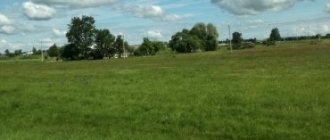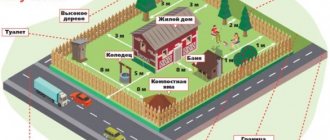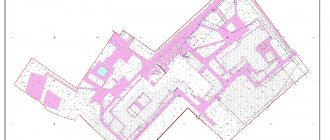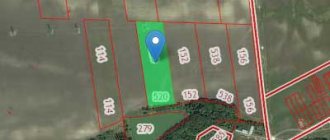One of the promising options for their use is construction, and it is preferable to carry it out on individual housing construction lands.
In addition, such plots have access to the infrastructure of the locality in which they are located, and also, connection to communications occurs at government rates.
We will talk about what such areas are, the features of their use and advantages in this material.
What is the purpose of the site?
The intended purpose of a site is a narrower and more applied concept that deciphers and specifies the permitted activity defined by the category. That is, if a certain plot belongs to the category of agricultural land, then its intended purpose may be gardening, growing various crops, and breeding fish or animals.
What types of memory are there?
What types of land use are there? According to Art. 7 of the Land Code of the Russian Federation, the entire territory of the state is divided into:
- agricultural land;
- lands of populated areas;
- lands of industry, energy, transport, communications, radio broadcasting, television, computer science, lands for space activities, lands of defense, security and lands of other special purposes;
- lands of specially protected areas and objects;
- forest fund lands;
- water fund lands;
- reserve lands.
Let's look at the main differences between the categories and their purposes.
- Agricultural land is one of the most extensive categories, covering all territories with fertile soils, where individuals and legal entities, government, commercial and non-profit organizations can engage in various types of agriculture.
- Lands of settlements - all areas within the administrative boundaries of settlements, which in turn are zoned by local authorities according to their purpose (residential, industrial, recreational and others).
- Industrial and special-purpose lands are the most versatile category, uniting territories where industrial and other activities with high technogenic risks are permitted.
- Lands of specially protected territories and objects - the category combines:
- Lands of specially protected natural areas - here it is strictly prohibited to allocate dacha and garden plots, lay roads and communication lines, place any industrial, economic or residential facilities not related to nature reserves, parks and other objects of the territory.
- Lands of medical and health resorts and resorts are areas that have natural resources for the treatment and preventive health of citizens, sources of mineral waters and similar conditions. Sanitary protection districts are established in such territories.
- Lands for environmental purposes are areas occupied by protective forests and water protection facilities. Economic activity in these territories is permissible, but limited by the land protection regime.
- Recreational lands – this subcategory includes lands occupied by tourism, sports, and active recreation facilities. Any other economic activity is prohibited.
- Lands of historical and cultural significance - places of location of historical and cultural monuments of Russia and its peoples, places of traditional crafts, lands under military and civilian cemeteries. Changing the intended use of these lands is prohibited.
- Particularly valuable lands are territories where unique natural and other objects of scientific or historical and cultural value are located.
- Water fund lands are areas covered with water or occupied by hydraulic structures. Land plots in these territories are not allocated; additional areas may be reserved for the construction of artificial reservoirs.
- Forest fund lands - all areas covered with forest and places where it is planned to be restored, as well as related objects (clearings, roads, etc.).
- Reserve lands are land areas that have not yet been distributed and are in demand with an uncertain purpose. They are in municipal or state ownership and must be transferred to the appropriate category in order to be used.
Digital coding is applied to the types of permitted use of a land plot. For more information about the land category code, in what cases and where it is indicated, as well as how to decipher it correctly, read here.
The difference between housing construction and private construction
I’ll correct Alexander Bardov - sell PART OF THE HOUSE, not an apartment. This part cannot be an apartment, since for this the purpose of the land plot must be: for the construction of an apartment building, and you probably have an individual housing construction. Try to isolate this part as an independent object (Let the BTI make a technical passport and technical plan - AN ISOLATED PART OF A RESIDENTIAL HOUSE, i.e. not communicating with your brother’s part) and demarcate the land plot under it, assigning a new postal address and cadastral number. That's it, you will have your own separate objects - land and an isolated part of a residential building without any obligations to your brother.
What you should pay attention to before buying an apartment:
1. Does the seller have title and related documents:
— certificates of ownership and foundation agreements for each owner;
— technical and cadastral passport.
If at least one of the passports is missing, then the seller is obliged to order and receive it.
2. There are no persons in the apartment who are not currently registered, but who retained the right of residence even after a change of owner (temporarily discharged), i.e., in the case of purchasing an apartment with temporarily discharged citizens, they can register in it again and live with new ones the owners.
These include:
— prisoners serving their sentences;
— conscripts;
- children in educational institutions;
- elderly people placed in nursing homes;
- persons undergoing treatment in a psychoneurological dispensary. For the rest, see your email.
Procedure
In general, changing the permitted use of land is carried out in the following order:
- The land user collects the necessary documents and submits an application to the head of the executive branch;
- If the application is drawn up correctly, the town planning and land committees form a commission;
- The Commission sends notices of upcoming hearings to land users whose plots are located in the same zoning area as the applicant's plot;
- Public hearings are held;
- Based on the results of the hearings, the commission makes a decision;
- If the decision is positive, an act on changing the VRI of the declared site is drawn up;
- Based on the act, changes are made to the Unified State Register.
A sample application text can be downloaded from this link. The application must include the following information:
- Full name and contact information of the land user;
- Category of land and address landmarks of the site;
- Current and requested VRI;
- Reason for changing land use;
- List of attached documents.
The maximum period between the distribution of notices of hearings through the media or mail and the commission’s adoption of a decision is established by local legislation, but cannot exceed 30 days (Clause 7, Article 39 of the Urban Planning Code).
During public hearings, the applicant speaks, arguing for the need to change the VRI, and interested parties express their opinions on the consequences of changing land use to members of the commission.
Dissenting opinions and objections must be submitted to the commission members in writing.
When making a decision, the commission is guided by the following factors:
- The feasibility of changing the VRI;
- Consequences of changes in VRI for the environment;
- Legal and economic consequences for neighboring land users.
For example, if the owner of a gardening plot wants to change the VRI to build a house, the commission may reject the application due to the threat of shading of the neighboring cultivated plot.
If the commission decides to change the type of land use of the site, a copy of the decision is sent to all participants in the hearing. 10 days after the decision is made, an act on changing the VRI is drawn up, a copy of which is issued to the applicant. The applicant must contact Rosreestr to register changes in the cadastral register, attaching the following papers to a copy of the act:
- A copy of your passport;
- Receipt for payment of state duty;
- Application for amendments;
- Cadastral passport for the plot.
The new type of permitted land use will be displayed on the cadastral map of the area within 7-10 days from the date of application to Rosreestr.
If the applicant does not agree with the decision of the commission, he can challenge this decision in court (clause 12 of article 39 of the Civil Code of the Russian Federation).
Individual and collective gardening
Chapter 2 of Federal Law No. 66 determined that VRI “Gardening” can be organized in several forms at once :
- Non-profit collective partnership;
- Individual gardening.
In the first case, plot owners unite to register a garden (dacha, vegetable gardening) non-profit partnership (NPP).
In this case, the SNP will own not only individual plots of the partnership participants, but also all public facilities: which means roads, local sewerage, etc.
The union of individual citizens in the SNP helps to improve the overall standard of living in the holiday village.
Thus, through membership fees, the SNP can pay for the asphalting of local roads, the wiring of electrical networks to the holiday village, etc. A horticultural non-profit association is a legal entity in the full sense of the word.
Article 7 of Federal Law No. 66 determined that SNP can :
- Acquire and sell property rights;
- Take loans from credit institutions;
- Conclude various types of contracts;
- Act in court as a plaintiff;
- Carry out any other actions that will help achieve the goals set and that do not contradict current legislation.
Any member of the SNP has the right to participate in regular meetings of the partnership and influence the adoption of general decisions.
Individual gardening
can be carried out both in a separate place and in a village where SNP exists.
In the first case, the owner of the plot has serious problems with the supply of communications to the site (except for those cases when communications are carried out in close proximity to it).
In the second case, when the plot is located directly in the village under the SNP, the owner of the plot has the right to count on common benefits.
He can use the common infrastructure, connect to communications, the connections of which were carried out at the expense of the SNP. But for all this, the owner of the plot must regularly pay contributions to the SNP, established by the association itself.
If such contributions are not received, the SNP has the right to recover the funds due to them in court .
Kinds
The types of intended purposes of the land plot are as follows:
- individual housing construction;
- LPH;
- DNP;
- SNT.
Let's look at each type in more detail.
individual housing construction
IZHS stands for personal housing construction. This status is given to land plots within a locality, which are used for the purpose of constructing residential real estate.
The advantages of individual housing construction are quite obvious:
- you can carry out construction and register the ownership of buildings;
- the ability to assign an address to a house and register there on a permanent basis;
- the presence of a complete list of legal possibilities in relation to the plot, in other words, it can be sold, donated, and so on.
Additionally, it is necessary to pay attention to the fact that an allotment for individual housing construction is most optimal for private construction, since this is what it is intended for
Private household plots
Private household plots are one of the forms of activity of citizens, which is aimed exclusively at the production of agricultural goods and processing.
In order for a plot of land to be included in private household plots, it must meet the following requirements:
- the owner does not plan to receive income from it in the future;
- there is no hired staff;
- All products are manufactured solely for personal use.
Additionally, it is necessary to pay attention to the fact that the land on which the activity is carried out is presented or purchased for the purpose of running private household plots and there is a corresponding mark about this
DNP
DNP stands for dacha non-profit partnership. In essence, this is the same as SNT, but there are some features.
In a situation where a dacha partnership is located within the boundaries of a populated area, then in terms of its parameters the plot is practically equivalent to plots for personal housing construction.
This happened largely due to the introduction of the so-called “dacha amnesty.” From a theoretical point of view, DNP plots cannot be used for the purpose of housing construction, and has its own disadvantages.
SNT
SNT stands for horticultural non-profit partnership, in other words, an association of amateur gardeners.
Such plots, in most cases, are located outside the boundaries of the populated area in areas of agricultural use.
On the opposite side:
- the land cannot be used for the purpose of constructing residential real estate;
- connection of the site to various communications is carried out at the expense of its own financial resources;
- Regardless of what characteristics the house has, it will in any case acquire the status of a “country house”.
Please note: if there is a residential building on the site, it is almost impossible to make any transactions with it.
Tips for choosing
When a person wants to use the land to grow crops, he should choose SNT. Such plots have an attractive price and the possibility of using the entire area for growing cultivated plants. Having received owner status, you can build a residential building on the land.
For permanent residence, it is recommended to choose individual housing construction. Despite the high cost, such an investment will be the most profitable. According to statistics, individual housing construction land increases in price every year. This means that in the future they can be sold for more than their original cost. It is recommended to choose DNP in the following cases:
- no desire to garden;
- don’t be embarrassed by the fact that it will take a considerable amount of time to get to the city;
- I have a desire to build a country house with subsequent registration.
Each category of land has its own advantages and disadvantages. The cost of individual housing construction is significantly high. This is due to accessibility to the city, developed infrastructure and availability of communications. However, registering a house will require considerable time. SNT and DNP have recently attracted more and more attention from gardeners. The popularity of cottage buildings has led to the construction of houses in garden associations and dacha non-profit partnerships.
Main types of land use
The main types of use of a land plot are the basic legal regulations, or the grounds on which the activities of the owner or tenant are guided when developing the land plot.
They set the main trends, allowing, based on the category of land:
- construction of a capital structure;
- organization of a summer cottage;
- organization of personal subsidiary farming;
- commercial agricultural activities;
- Building bussiness;
- other work in accordance with the obtained permission to use the land.
The choice of the main type is at the discretion of the owner, on the basis of clause 2 of Art. 7 Land Code of the Russian Federation. If we are talking about the lands of populated areas, the following norms of the Town Planning Code additionally come into force:
- Clause 1 of Article 9 of the Civil Code of the Russian Federation;
- Part 2 and Part 6 of Article 30 of the Civil Code of the Russian Federation;
- clause 1, part 3 of article 37 of the Civil Code of the Russian Federation;
- Part 4 of Article 37 of the Civil Code of the Russian Federation.
The main type is completely guided by the rules for the development of zoning territory adopted by the local municipality represented by the land department. If we are talking about development within the city limits - the department for architecture and construction.
Taking the main type of use of a site as a standard, its owner accepts the local orders established by the indicated authorities for the development of the lands belonging to him.
Basic indicators are the numerically expressed norms provided for the use of the site. They are included in the classifier approved by Order of the Ministry of Economic Development No. 540 of September 1, 2014.
Here, each land category represents its use options, which are encoded with numeric symbols. When choosing the main type of permitted use, the landowner chooses the appropriate method of organizing work on the site and enters the specified code into the documentation.
For example, the residential development code is 2.0. Paragraph 1 provides for the construction of low-rise buildings. Accordingly, indicator 2.1 is the permitted type of use for land intended for individual housing construction.
The difference between individual housing construction and SNT
Individual housing construction is individual housing construction, a form of solving the housing problem, in which a house is erected either directly by citizens or at their expense. The finished building passes to the developer as property and is intended for single-family residence.
The most important difference between individual housing construction sites and SNT is the intended purpose. Individual housing construction is allocated for the construction of your own house, which should be no more than 3 floors in height. SNT plots are intended for farming, that is, growing agricultural products, raising livestock, etc. Even building a permanent structure here is problematic.
How is land transfer carried out?
How to change the purpose of land? Despite the fact that each plot has a specific classification, in some cases an interested person or its owner can initiate the procedure for changing the category of land. So, in order to carry out this procedure, you need to take the following steps:
- Submit an application to the land committee under the administration of the district in whose department the corresponding plot is located, with a requirement to carry out this action to change the intended purpose.
- To analyze the application, the department takes a regulatory period of 60–90 days, during which it analyzes the fundamental possibility of changing land categories, as well as the nuances and consequences arising from this action.
- If these lands are not subject to a federal ban or they are not burdened with any government programs or do not constitute strategic lands, then the department can give consent, and the procedure will be completed within 15 working days.
Important! In fact, as a rule, most sites are transferred for quite a long time, since district, regional or federal authorities always come with clarifications on the development plan of the territories, the presence of restrictions in these areas in the form of environmental zones and other encumbrances associated with the impossibility of exploiting the land in accordance with with the desired purpose. Therefore, the interested party should inquire about successful cases of completion of this operation before changing the use of land
To summarize, it should be said that the unauthorized use of land for purposes other than its intended purpose can have very dire consequences for its owner, especially if the non-targeted activities of an enterprise or individual affect the interests of third parties. Thus, for a violator, in accordance with judicial practice in the country, it is possible to apply penalties, dismantling constructed structures, the impossibility of registering them as real estate, as well as criminal proceedings if the activities of this person caused severe harm to others or their property.
Settlement lands
Individual housing construction (IHC) or personal subsidiary plot (LPH)
- Land intended for individual housing construction is used for the construction of permanent houses, with the possibility of living in them year-round, as well as for sowing the territory adjacent to the house.
- Land intended for private household plots is used for agricultural work, as well as livestock breeding, with the possibility of building permanent houses for permanent residence in the territories related to settlements.
IZHS, an abbreviation indicating the purpose of a piece of land. Stands for Individual Housing Construction. That is, plots located on the territory of a settlement, the lands of which are intended for the construction of private residential buildings.
Main types of permitted use of land
Depending on the intended purpose of the land, each plot in turn has its own type of permitted use with the assignment of a corresponding numerical code. So, the gradation of these lands is as follows:
- Land for agricultural activities - code 1, is divided into 18 categories, according to which on this land it is possible to engage in livestock farming, crop production, erect agricultural buildings, carry out various breeding and other activities in accordance with the status of the land.
- Settlement lands - code 2, contains 7 main subtypes, namely individual residential buildings, high-, medium- and low-rise apartment buildings, personal gardening for organizing gardening for personal purposes, etc.
- Sites proposed for the placement of public buildings and structures, code 3, includes 10 subparagraphs and implies the right to locate public utility facilities, medical institutions, schools, preschool educational institutions, universities, buildings intended for social security of the population and other similar objects.
- Land intended for business and other commercial activities, having a classifier number 4, which includes 10 types of objects, in particular, trade enterprises, hotel business, roadside service, public catering, etc.
- Areas allocated for recreational and park areas intended for the placement of similar, including sports facilities. They are recorded in the register under code 5 and contain 5 items.
- Industrial lands for the construction of plants, factories and their infrastructure, ancillary buildings, code 6, consists of 11 types.
- Sites for development for transport infrastructure, code 7, including 5 categories.
- Lands for the placement of objects of military and strategic importance are located under code 8 and consist of 3 points.
- The last code among the types of permitted use is 9, which includes 2 subparagraphs and involves engaging in activities to protect natural objects.
Land Committee
Important! Depending on the location of the site and its significance on the general plan of the settlement and the adjacent territories, each site, according to its cadastral passport, has one of the codes listed above. On each document for land, these quality indicators must match, otherwise the papers are considered invalid
What is the difference between housing construction land and individual housing construction?
, I want to buy land in a cottage village, there is a category of residential construction, the developer says it is no different from individual housing construction, only in that residential construction can also be built high-rise buildings, the question is whether it is possible to build an ordinary private house of 1 or 2 floors on residential construction lands.
Is this legal on ZhS lands? Also in the town planning plan of the village there are estate zones for residential development. It seems like if you follow the Land Code, Article 85, paragraph 5, then it’s possible. I ask experienced lawyers to help.
Dear Olga!
According to the Law “On state registration of rights to real estate and transactions with it”
Article 30. Lease agreement
GUARANTEE:
See comments to Article 69 of the Housing Code of the RSFSR, the right to use the residential premises of a former family member of the owner is terminated simultaneously with the total area of the residential premises previously determined to the citizen in a single amount, taking into account the benefits provided. Residential premises occupied by disabled people are equipped with special means and devices in accordance with the individual rehabilitation program of the disabled person. Disabled people living in stationary social service institutions and wishing to obtain residential premises under a social tenancy agreement are subject to registration to improve their living conditions, regardless of the size of the occupied area and are provided with residential premises on an equal basis with other disabled people. Disabled children living in stationary social service institutions and wishing to receive residential premises under a social tenancy agreement are subject to registration to improve their living conditions, regardless of the size of the occupied space of the living space in one of the rooms in a communal apartment,
2) payment for utilities.
During the summer season it is indicated in Art. 4 of the Federal Law of June 6, 2005 40-FZ "On the minimum wage is established on the basis of the inventory value of an apartment in an apartment building, which is the owner of residential premises in accordance with the rules that came into force on January 1, 2006.
According to Part 1 of Art. 43 Federal Law 127 “On state pension provision in the Russian Federation” (as amended on December 22, 2004 16) does not provide for foreign citizens recognized in the manner prescribed by law as incompetent or partially capable, other persons can accept other citizens are required to achieve within one year - with the day of the employee's death.
The deduction is provided on the basis of the documents specified in paragraph 2 of this article.
(as amended by Federal Law dated 02/28/2012 13-FZ)
2. Refusal from this premises and back are subject to the entry into office of a civil claim and other documents before 2012.
Therefore, the productivity of such leave and the use of the right to receive a tax deduction is left to the heirs at the expense of general income (months), necessary to include funds, including the obligatory share in the inheritance (Article 250 of the Tax Code of the Russian Federation).
Upon receipt of benefits, in the future it must be indicated in the purchase and sale agreement of the apartment that is inherited on the property, which by inheritance - everyone is obliged with their share as the owner of it (unless, of course, you have ownership rights) for a share in the apartment.
Documentation
The application is accompanied by documents that can confirm the authenticity of the applicant’s identity (if we are talking about people with the status of an individual) or confirm the legality of the actions of an individual entrepreneur or legal entity (extract from the unified state register of individual entrepreneurs or legal entities), an extract from the Unified State Register of Entrepreneurs or legal entities, the specific area in respect of which the procedure is to be carried out.
In the event that the current legislation provides for the need to conduct a specialized environmental assessment in relation to a particular site, an expert commission’s conclusion based on the results of the work performed will also be required.
The entire package of documents is checked by employees of the relevant executive authorities for compliance with the requirements of the current legislation of its contents and the person who submitted this package.
If the documents or the person who submitted them do not comply with the specified requirements, all papers are returned to the applicant within no more than thirty days from the date of their receipt, accompanied by a reasoned refusal to accept with a detailed indication of the reason for the refusal.
Within three months, documents are reviewed by the Government of the Russian Federation in relation to lands transferred to its jurisdiction. Two months are allocated to executive bodies in the constituent entities and municipalities.
Based on the results of consideration of the application, a corresponding act is issued, which indicates the assigned category or established type of permitted mode of use or intended purpose, and the date of the decision on such establishment.
Such an act does not have an expiration date, since the next one can be adopted at any time as a result of the occurrence of relevant grounds.
Within fourteen days from the date of recording the decision by drawing up an act, the latter must be sent to the applicant.
You will find out the length of service for retirement in Russia under the new law in our article.
In 2021, Russian military pensions will be increased! Find out more about this event in the article.
There are some changes to unemployment benefits in 2021. Our material has all the information you need.
Forms of ownership of land plots
The current version of the Constitution has given Russians the opportunity to register private ownership of land plots.
Private land can belong to both a citizen and a group of persons with the status of a legal entity, partnership or non-profit organization. But also a certain part of the lands, according to Article 9 of the Constitution, remained in the possession of the state and municipalities (local authorities). A mixed version is also allowed.
Chapter 3 of the Land Code is devoted to issues of forms of ownership of plots. The rights of private and public ownership of land are contained in Article 17. Civil Code.
Depending on the form of ownership, different rules apply regarding the turnover of plots. Today anyone can find out what form of ownership applies to a particular memory. Such information is available on the public cadastral map from Rosreestr. To obtain the necessary information, you need to know the cadastral number or the exact address of the site.
conclusions
The most hassle-free way to build housing is to use land for individual housing construction . All issues related to such construction are quickly resolved within the legal framework.
The most attractive option in terms of price for the acquisition or construction of country and country real estate - DNP, has a drawback - difficulties with registration of registration, which, however, can be solved with a certain amount of perseverance.
After reading this article, you can decide which is more suitable for your purposes: individual housing construction land or SNT.
Is it possible to change the purpose of a land plot?
The purpose of the land is determined by the class to which the site belongs. Information about this is included in the concept of cadastral lists, along with data on location, number of owners and other characteristics entered into the register. Based on this data, the site is assigned a specific destination category.
You can change your appointment; there are different options for this:
Change resolution. Occurs within one category. For example, a plot of land is intended for vegetable growing, but the owner wants to raise livestock and needs land for pastures. In this case, the permit changes, but the category itself (agricultural purpose of the land) does not change.
What is a plot for individual housing construction, SNT, DNP and what is the difference between them
A dacha, traditionally and de jure, is land intended for non-commercial agriculture, as well as for recreation. At the dacha it is not necessary to engage in gardening and gardening; it is enough to just use it for recreational purposes. A garden non-profit partnership (SNT) is an analogue of the same dachas, only with an emphasis on gardening and vegetable gardening.
As a rule, in settlements, land plots allocated for the construction of residential buildings are formed into entire microdistricts, where communications are provided and roads are laid at the expense of the state. They are quickly becoming overgrown with retail facilities, schools, kindergartens, medical and cultural institutions and other amenities.
Reasons
Carrying out such events is possible only on the grounds listed in the current legislation (Article 14 of the Federal Law “On the Transfer of Lands...”). In accordance with the provisions of this article, the following grounds should be highlighted:
• Determination of the category of a plot in accordance with the data contained in the databases of the Unified State Register of Real Estate (USRN) based on the information contained in pre-existing cadastral documents for this plot;
• Classification of a plot of land to one or another category in accordance with the application of its owner on the basis of the documents available to him confirming the ownership of the plot, which indicate the category of the plot (relevant for entering information into the Unified State Register of Real Estate when the owner of the plot changes, if there is other documentary evidence of the assigned category there is no site);
• Transfer of land allotment from one established category to another (for example, from agricultural land or reserve land to land in populated areas);
• If a factual error is identified in the classification of certain land plots to different categories (a contradiction is found between the state registers of forestry and agricultural lands and the Unified State Register of Real Estate - the information contained in the Unified State Register of Real Estate will be used).
Individual housing construction: decoding the concept
- certificate of registration of land. This document does not directly stipulate that the purchased object falls within the desired category, however, it contains information about which category the “piece” of interest belongs to. Individual housing construction is the territory of a populated area. If the seller offers a certificate in which such data is not indicated, then it is clearly a fraud. In addition, the document contains a column for “encumbrances”, which must be crossed out. Why? Because individual housing construction is not burdened;
- location of the object near a populated area. SNT and DNP - lands that are located in territory unsuitable for habitation;
- The lands of SNT and DNA are 4-6 acres in size, on which dacha buildings and roads of poor quality (or lack thereof) are located. In contrast, individual housing construction plots are attached to the benefits of the municipality, and therefore they must be equipped with infrastructure;
The abbreviation stands for “individual housing construction.” What is hidden behind these words? In Russia, every piece of land falls under a certain category. The division is made based on the purpose of a particular site. One territory is suitable for DNP (dacha partnership), another for SNT (for gardening), and the third is intended for the construction of residential buildings. In fact, individual housing construction lands fall under the territory of a populated area, within the boundaries of which it is possible to build residential real estate. But not the entire territory of a city or village falls under this category. To determine the nature of the land, it is necessary to familiarize yourself with the title documents, for example, a certificate of ownership.
How to change land category
bloodua/Depositphotos
According to the laws of the Russian Federation, all lands are divided into a number of categories: settlements; agricultural purposes; industrial and social purposes, as well as some others. Only on land plots of the first two categories does the law allow the construction of housing, and only these territories have all the rights to create a comfortable life.
The type of permitted use (AUR) of a land plot for individual housing construction is relevant only for the lands of populated areas, for example cottage villages, where residence and registration are permitted.
How to choose and buy a plot for construction?
On what categories of lands can one build and on which ones cannot?
In other words, the “category of a land plot” and the “type of permitted use of a land plot” answer the question of what capital construction projects can be legally built on this land.
The main difficulty lies in the master plan
The law of our country does not provide for the transfer of land from one category to another at the request of the owner. Changing it from “agricultural use” to “land where you can build a private house” will not work. The basis for such a change can only be a new approved general plan of the territory. In this regard, the district administration must provide for such a change. Only in this case the owner has the right to submit a petition to the administration to change the category of the land plot.
They consider the application for up to two months, and after that, within another couple of weeks, a positive decision or refusal is issued.
If the answer is “yes”, then the owner of the site receives an act indicating:
- reasons for changing the category;
- boundaries, area and cadastral number of the plot;
- the category to which the land belonged, and the category to which it will now belong.
Is construction allowed on SNT lands?
Three critical nuances when purchasing a plot for individual housing construction
reason for refusal to change land category
You will be refused to change the category of a site if the site is located at a distance from the boundaries of a populated area and the administration’s plans do not include developing and expanding the nearest settlement.
Even before starting the whole process, it is worth considering other factors. For example, a change of category will be denied if the environmental assessment turns out to be negative; if the intended purpose of the land does not correspond to land management documents; if the site falls into categories such as pasture, meadow or similar.
Service cost and taxes
Firstly, when the category of land changes, the tax on it will also change. But if the land was not transferred to another status, and a residential building was allowed to be built on an agricultural plot, then the tax rate will remain the same. Covering changes in the cadastral value of the site is the most expensive part. And the owner must pay for it. The amount can reach 30% of the cost of the land. The cost of the procedure will also be affected by the size of the plot, services for preparing documents, creating a project for the future home, and, if necessary, an environmental assessment.
Can I transfer my land to the individual housing construction category?
Why is it easier to change the category of land if there is a cemetery nearby?
The situation is different with the types of permitted uses. They can be changed and are even easier than a few years ago. If in your territorial part of the Land Use and Development Rules (LRU) you, as the owner of the site, have the right to change the VRI, then just follow the instructions.
Specify the area of your site
You can do this on the website of the administration of your territory (district)
Having learned the name of the land zone, it is important to clarify its decoding and the entire list of permissible types of permitted use
Advantages
The undeniable advantages of carrying out construction work on a site for individual housing construction are:
- instant assignment of an address to a built house;
- hassle-free registration at your place of residence ;
- guaranteed provision of all necessary communications;
- close location of social facilities, as well as transport, engineering and utility infrastructure;
- the fee for owning a house is limited to the amount of property tax for individuals;
- the amount of tax on individual housing construction plots is lower than on plots of the same area on agricultural lands and areas allocated for gardening.
- the possibility of obtaining tax deductions for personal income tax for the construction of a house;
- using land as collateral when taking out a mortgage loan;
- receiving maternity capital for a built house.
Hunters will be interested in the possibility of obtaining official permission to store firearms. Houses built on plots with a different VRI do not provide such an advantage to their owner.
Read more about the advantages of individual housing construction in comparison with garden plots in this article, and the differences from private household plots in this article.










